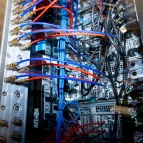Artificial Intelligence–Based Drought Prediction

Drought monitoring and early drought prediction are of great importance for water resource management, farming, and assessment of wildfire risk. Recently, scientists from NASA Jet Propulsion Laboratory (JPL) and elsewhere have demonstrated that estimates of temperature and humidity near the Earth's surface, derived using NASA’s Atmospheric Infrared Sounder (AIRS) aboard the Aqua spacecraft, can detect drought onset in the continental United States months before other drought indicators based on precipitation or soil moisture. For years, Lincoln Laboratory has contributed to AIRS algorithms to enable this application, including a neural network approach for estimating vertical profiles of temperature and water vapor before additional scientific processing takes place to generate the full suite of AIRS products. In recent years, the AIRS project team at JPL has provided a drought indicator as an input to the U.S. Drought Monitor, which is a map of drought conditions created to warn the public and inform disaster declarations.
While this past work has been successful, there is significant room for improvement and further development. Aqua and AIRS are near the end of their life after over 20 years of successful operation, and no suitable drought indicator currently exists with newer observatories. In addition, the current AIRS drought indicator can be significantly improved by using a neural network algorithm dedicated for this application, with improved quality control and uncertainty quantification to make better use of the available instrument data, newer training sets, and updated neural network architectures.
This project will develop this improved neural network approach, and demonstrate drought prediction that is expected to exceed the capabilities of the existing AIRS indicator. This project will use data from newer observatories and will ensure that this application can continue to be made for decades to come without gaps. We are grateful to scientists at JPL for introducing this drought application and collaborating with us on this effort to improve it.



